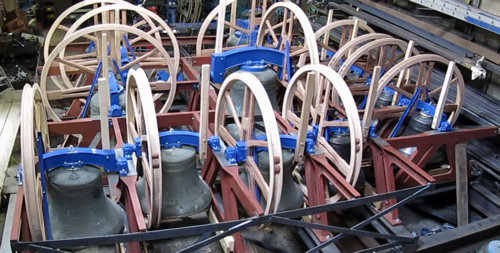
The bells in their new frames.

Sam Hallas' Website

The bells in their new frames.
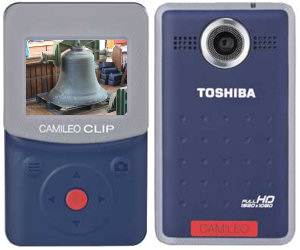
In correspondence with Robert Gordon about his Inverness bells video, he mentioned that he had thought about attaching a camera to one of the bells as it was hoisted into the tower. This sounded like a great idea and set me looking for a camera that could be used. There was a danger of the camera falling off, so a cheap one would cause fewest tears if it fell to its doom.
After a good deal of research on Google and Amazon, reading reviews and comparing prices I decided that Toshiba's Camileo Clip camera at just uder £30 was the one for the job. It takes HD video at either 720p or 1080p and will also do timelapse at 1, 3 or 5 second intervals. It uses a micro SD card for storage.
It's cheap enough not to worry me if it breaks. Mind you, it has a rubberised coating so I suspect that it would bounce if dropped. It arrived pretty quickly from Amazon and I set about testing it. With a fully charged battery I left it taking one second timelapse out of the bedroom window again. It ran for at least two hours before I stopped it. That was quite long enough for my needs.
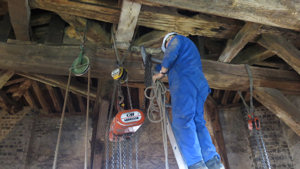
Fixing the hoist
Another work session approached towards the end of April when the old beams and girders would be removed from the tower. The new beams would go in to allow time for the builders to finish the brickwork and the mortar to set before the bells came back.
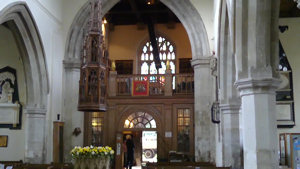
Still from timelapse
This time I was able to catch shots of the bell hangers arriving and settting up the hoists. I was able to use those shots later in the final video compilation to illustrate the work that I missed in November.
The Monday was spent taking out the old beams. I was able to try out the Camileo Clip as a time lapse camera. On the right is a still from one of the sequences of lowering the beams. The menu structure is a bit fiddly to set up for timelapse and it forgets the setting once the power is turned off. The images are sharper than the ones from the webcam. Even so the Camileo's sharpness is not as good in indoor lighting as it is in daylight outdoors.
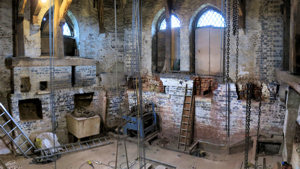
The empty bell chamber
Once the old beams were out I created this composite image (left) of the empty bell chamber. It's stitched together from six still images using the panorama editing program called PhotoStitch that comes with Canon cameras.
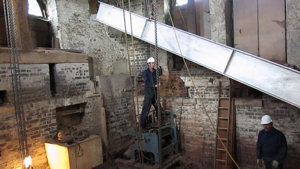
A new beam goes in
Tuesday was a day off. On Wednesday the new beams arrived on a lorry, were offloaded and hoisted up the tower. By now I was getting the hang of keeping my video shots short. Between 5 and 12 seconds has turned out to be plenty long enough. A greater number of short shots seems to produce a more varied final sequence.
The bells would not be arriving for several weeks, so I edited the pictures into another five minute video. I called it 'Preparing the Way', echoing the phrase from Isaiah 40 used in the Messiah: "Prepare ye the way of the Lord."
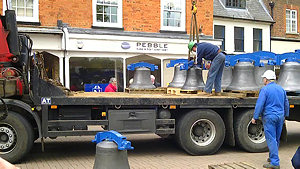
Unloading the lorry
The second week in May 2013 saw the bells arrive back from the bell hangers at Appleton in Oxfordshire. I'd learned that the plan was to unload them onto the driveway, so that the lorry could get away quickly. They would then be taken into the North aisle in the church to be on display for a week.
I set up the Camileo on a tripod where it could see the unloading. Then a crowd of onlookers gathered in front of it and I had to move it. I placed it just inside the tape barrier set up to keep the public clear of the work. Even so some twonk standing next to it managed to get his hand in shot as he took pictures on his mobile. That meant that only about half of the unloading sequence was usable. The shot on the left shows how sharp the Camileo's images are in daylight.
I followed the unloaded bells with the Canon in video mode and the results are remarkably smooth considering that they are hand held whilst I was walking. I set the Camilio up inside the church to show the bells being wheeled into the aisle. The results were very pleasing.
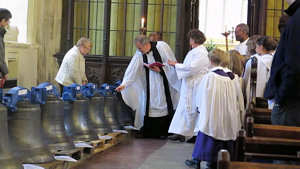
Anointing the bells
The bells were to be on display to the public for a week, but first there was a service of blessing on the Sunday evening. I attended this along with all the bell ringers. The Canon proved very discrete, allowing me to take stills and video without disturbance. I was able more or less to shoot from the hip - holding the camera at waist level where I could see the rear display to aim the lens (right).
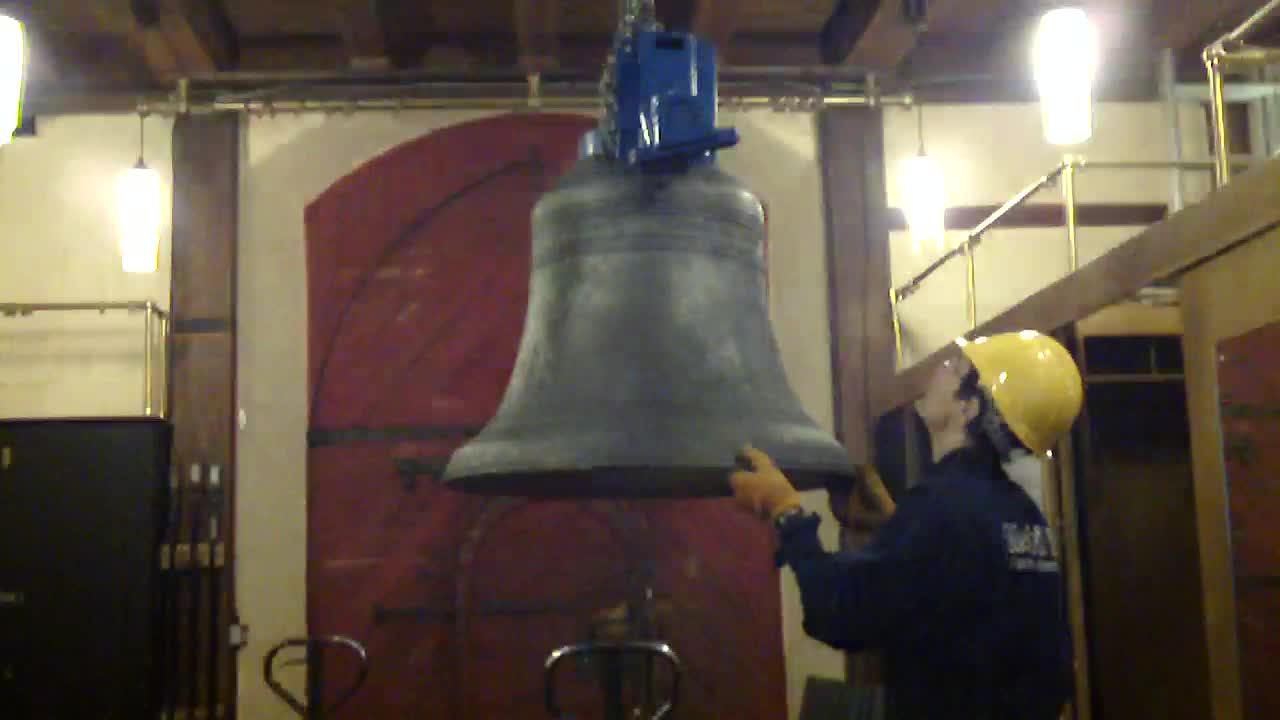
Raising the bell from timelapse
I took some record still shots of the bells to show the inscriptions. They will not be seen so easily until the next rehanging. Then it was time to hoist the bells up the tower. I set up the Camilio on a tripod at first for timelapse purposes. Later I moved the tripod about from the vestry (left) to the ringing chamber and then into the bell chamber. I performed a gentle tilt to follow the bell's motion. Although the shots show a different bell in each, after editing it looks like a smooth transition. As mentioned above, I stuck the Camilio onto one of the bells with gaffer tape and set it in timelapse mode. The result was not as good as I had hoped since the bell swung around as it rose. However, there was a 'Hitchcock moment' as the bell passed through the ringing chamber with a brief glimpse of me in overalls and hard hat, camera slung round my neck. Blink, and you'll miss it!
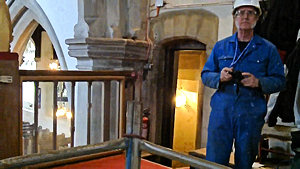
The 'Hitchcock Moment'
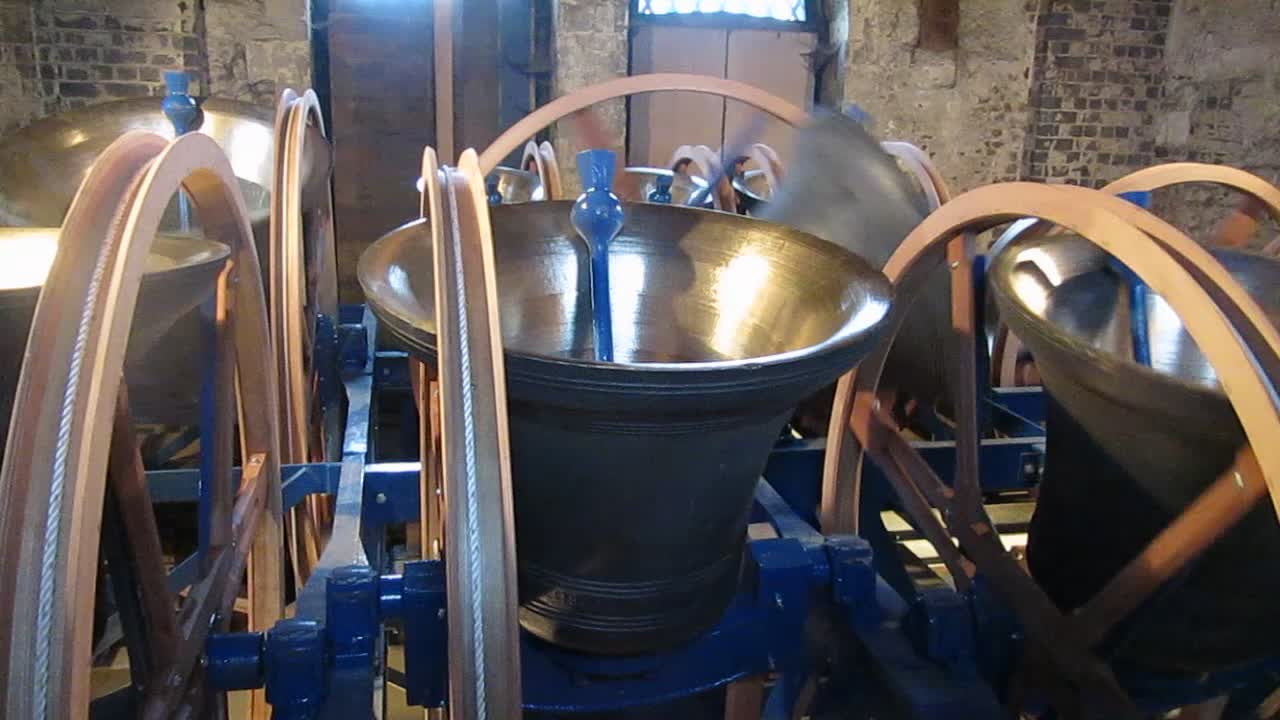
The bells in motion
With the bells back in the tower it remained to fit the wheels and ropes and ring the bells. There was a good trial ring mid-week, with ringers from around the county trying out the new bells. Having put on my ear defenders I went up to the bellchamber and took some video shots of the bells in motion (right).
The ringers assembled on the following Sunday, 2nd June 2013, to ring a full peal as a double celebration of the new bells and HM Queen's coronation 60th anniversary.
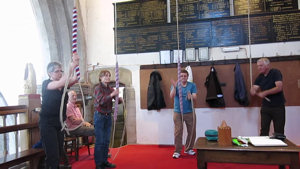
Celebratory peal
I was able to video the ringers as they rang the bells up before they shut themselves in to the tower (left). Outside I set up the sound recorder again. This time I placed it under the tailgate of my car to shield it from the light breeze. Although the batteries would probably last for the full three hours of the peal I decided that two hours and five minutes was enough to compare the sound of the new ring with the old.
I had in mind that I would finish my video with shots of the town centre inter-cut with the swinging bells from earlier. So I wandered out into the market place and round the church, taking advantage of the sunshine, and took some stills.
I've called the last video in the sequence, 'The Happy Return' - rather like the phrase 'Many happy returns'. See, I didn't call it 'Ring in the new' after all. It's eight minutes long.
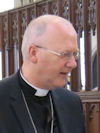
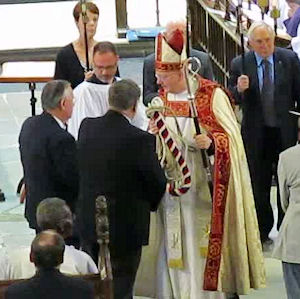
Presenting the token bellrope
I had promised to make a composite video of the complete operation from start to finish. St Mary's bellringers desired to have it duplicated for sale in time for Christmas.
The Bishop of St Albans, the Rt Revd Dr Alan Smith, (left) came to conduct a service of dedication in September 2013. Including this in the final video would be a fitting postscript to the project. The Bishop himself is an accomplished a bell ringer, so he was able to join St Mary's ringers for a short spell before the service.
The service proved tricky to video as part of it took place in the nave and part in the ringing chamber. I thought at first that I might stand in the nave with the bellringers during the presentation of a token bell rope and then dash ahead to the chamber. However, the view of the nave from the chamber was good enough to allow me to be there for those parts of the service. The whole thing was complicated by a request from an absent member for a sound recording. I was able to cobble some sort of recording together despite the sad state of St Mary's sound system. It still entailed some frantic rushing up and down the spiral stairs from the vestry to the ringing chamber.
Looking back on the files I created, I see that for the events covered with the Canon G15 I've taken a lot more stills than I did in November. This seems to me to be an advantage as the stills on their own can form a fairly complete record of the process independent of the video sequences. It's obviously a reflection of the ease with which I can switch from one mode to the other.
I certainly consider the G15 a good investment for this type of event photography, despite the price. It's small(ish) and light. It's also versatile, taking stills in 4x3, 3x2 and 16x9 aspects, and HD video in 720p or 1080p. Its autofocus is fast and the autoexposure in Program Mode is accurate. The image stabilisation is impressive. Hand held videos were excellent.
The Toshiba Camilio Clip I also consider a good investment, especially for its price. I was aware of its limitations but decided that it would be adequate for my purpose. In the event it proved better than expected in many respects although low light performance is weak, as I knew. Being so small it's quite difficult to keep steady in your hand. On a tripod it worked well, though such a tiny camera on a huge tripod looked rather odd.
Over the ten months of this project I think my skills as a videographer have improved. I've learned to take plenty of short sequences and to have some ideas for the final script in my head as I go along. Additionally I've found the ability to intersperse video with stills is a useful technique (and keeps the file sizes down).
I've passed CDs of the sound recordings to the Tower Captain, David Kemp. He's requested some excerpts of the new ring that can be passed round the ringers. To keep the still pictures for posterity I have passed a DVD of them to the Bell Ringers Association.
The final video was completed and duplicated in time to hit the Christmas market in 2013. It includes a short history of the bells and tower. It goes on to explain the reason for 13 bells instead of 12 with a little animation. The process of removing the bells from the tower is shown followed by the casting of new bells at Whitechapel bell foundry. St Mary's ringers are seen visiting the bell hangers, Whites of Appleton. Finally the bells return, once the tower has been equipped with the new frame to hold them. After a service of blessing the bells are seen ringing for HM the Queen's coronation diamond jubilee. The video ends with a service of dedication conducted by the Right Revd Dr Alan Smith, Lord Bishop of St Albans. The disc also includes ten minutes of short audio recordings of the bells before and after the rehanging.
Copies of the video were on sale at £10 and a few copies remain. Contact members of St Mary's Bellringers. You can watch the separate episodes on my Google+ pages. Click here to see the items. Sale of the video raised over £1600 which went to the Bellringers Association.
Some Sound recordings of the bells before and after the rehanging are on the St Mary's Bells Sound Page
When I started writing these pages in June 2013 I wondered what my next project would be. It turned out it was to record the start of passenger traffic on the new Hitchin railway flyover. More on that here
Back to St Mary's Bells, Part 3